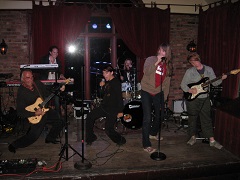This is mark Joseph “young” blog entry #384, on the subject of Game Ideas Unlimited: Introduction.
I must begin by thanking Regis Pannier and the team at the Places to Go, People to Be French edition for locating copies of many of the Game Ideas Unlimited articles which were lost with the crash of the Gaming Outpost website on which they were originally published. An effort has begun to restore as many of these as possible as entries in the RPG-ology series at the Christian Gamers Guild. However, the first article in the original series was primarily an introduction to the author–that is, to me–and as I had been introduced in several articles in Christian Gamers Guild series (Faith and Gaming and Faith in Play in addition to the one already linked) it was decided that the additional redundancy of yet another introduction was unnecessary.
I suppose the same argument could be made here. However, at the Christian Gamers Guild there is the limit that I post two articles a month, one in each series (sometimes an extra here or there if there’s something that needs to be posted that doesn’t fit either of the series), and here the limit is really just that I need to post things when I have something to post. In the interest of historical completeness I am here publishing the original first article in the Game Ideas Unlimited series. It was originally published June 1st, 2001. The links have been updated where possible and necessary, and there are a few [bracketed] editorial notes.
*****

Game Ideas Unlimited:
Introduction
by Multiverser author M. Joseph Young
I play Multiverser, and I love the game. But that's expected--my name is on the cover. E. R. Jones had been refining the idea for half a decade when he brought it to me, and I spent five years working with him to hammer out the details and the text. So you can take my opinion with however many grains of salt you wish. As long as it doesn't bother you that I'm a raving fanboy of my own game, we should get along fine. And I promise to mention it only when it matters.
So why do I mention it now? Well, for all of its strengths, the game is voracious. It consumes worlds and stories and creatures and ideas at an alarming rate. I've run as many as eight worlds in a single night, each of them completely different. It's one of the things that most frightens people about the game: where do you keep getting ideas? It's not that hard, really. I just mentioned an idea I'd written up to one of our long-time fans (someone who playtested the game before it went to print), and he said that he never needs to look for ideas because there are so many of them out there. He's right; ideas come easily, once you get in the habit. But if you're not in the habit, it's easy to get stumped. In fact, you don't have to play Multiverser to run short on ideas.
And that's where this column comes in. I've become something of an expert on generating ideas. I run my own games; I write game tips for Valdron Inc's Tip of the Week site; I develop ideas for game worlds and games for future publication. I've got some tricks I use, and some ideas I can share. And this column gives me the chance to share them.
There will be something a bit different here each week. Sometimes you'll find ideas for creatures, or for characters, with which to populate your game world. These will be suitably generic, so you can use them with whatever game you're currently playing. Sometimes I'll give you the basics of an entire game world, something you can use for a campaign, or perhaps something smaller like an unusual adventure situation. I'll also throw around ideas in game theory, ways to achieve different effects in your games, referee and player techniques, and other things I find useful in games I've played. You won't find every column useful to you. If you're into fantasy only, my forays into sci-fi might be of only passing interest; and similarly if you're a sci-fi gamer when I get talking about a challenging dungeon level concept you might find it less than practical. But I hope to go beyond just the practical ideas themselves to something far more practical: the patterns of thought that generate these ideas, the way I can always find new and creative ideas that keep my players going and constantly bring them back for the next game. I'm convinced that creative thought patterns can be taught and learned. I've learned them from others. I hope by this medium to teach them to you. Who knows? Maybe some of you will wind up writing brilliant new worlds for my future Multiverser sessions.
But perhaps some of you don't know me. I'd like to introduce myself. The best way I know to do that and make this column useful to you is to point you to a few of the things I've written that relate to gaming. That will give you some idea of how I think and what I think, and maybe whether it will be worth your time to come back next week for the second installment. It will also give you a fairly substantial reading list if you try to tackle all of it; there's a lot more out there than I'm going to mention here. But I think you'll find some of this useful. This isn't the only kind of thing I'll be writing; but it is the way I think about things. Oh--some of these are on other game support sites. I really don't want to send you away from the fine materials here at Gaming Outpost; but a writer's credentials are usually that he's been published in other places, so I'm going to have to offer you those other publications as a reference. As my father's Mississippi family might say, "Y'all come back now, y'hear?"
A couple years ago I tackled the problem of players who like playing evil characters. I'm not opposed to evil characters in my games; but I think that too many of them get away with murder. This was the first of my half dozen previous contributions to this site, Morality and Consequences: Overlooked Gaming Essentials [republished version], in which I examine how a referee should respond to the criminal, unethical, and immoral acts of player characters.
If you've seen the Australian e-zine Places to Go, People to Be, you know they have some wonderful material. It includes a three part series of mine, Law and Enforcement in Imaginary Realms. The three parts, The Source of Law, The Course of Law, and The Force of Law, look at how to understand and build legal systems including laws, courts, police, and prisons, which are consistent with the worlds you play but surprising to the players. Gaming Outpost liked this enough to reprint the first of these [here].
A lot of gamers today complain about what they see as the old-style gamer who focuses too much on winning and not enough on story. I gave some thoughts on this to Wounds Unlimited in Re-educating the Power Gamer. Johnn Four of RoleplayingTips.com thought the article so helpful he reprinted it on his site.
I've published quite a few web pages without the help of an e-zine; I won't burden you with all of them here. But I will mention Confessions of a Dungeons & Dragons Addict, my entry in the debate about whether role playing games are satanic. Obviously you know my answer (I'm writing for an RPG site); but my arguments might help yours, and there's a fair amount of my personal and gaming history included in the piece. This one gets a lot of attention--GAMA and the Christian Gamers Guild are among those linking to it.
You might be wondering why I haven't mentioned RPGnet. Well, I can't mention everybody. I've got articles in a lot of out of the way places (WebCMO has one of my contributions on One-to-One Marketing; I have some interests besides gaming). But indeed I do have an article there which might be of interest to you: Intuition and Surprise looks at just exactly what it is that gives a character that "feeling" that something is amiss, and how to use that in your games.
I try to keep current an index [alas, an effort abandoned years ago] of everything that isn't just a forum post or newsletter contribution. It's not all about games, but a lot of it is. And I make myself available by e-mail to discuss these or just about anything else.
Beyond that, there are a couple things I should mention. I've got two undergraduate degrees in theology and a juris doctore, that is, a graduate degree in law. I was accepted into membership in Mensa years ago. I'm the father of five boys, all of whom are avid and creative gamers. I've always been serious about my fun, playing and inventing games of many types since before I knew about role playing games. My interests have been quite diverse over the decades; expect that to show from time to time.
I look forward to sharing some of my as yet unpublished ideas. Next week, something different.
*****
As mentioned, additional entries are available at the Christian Gamers Guild.









